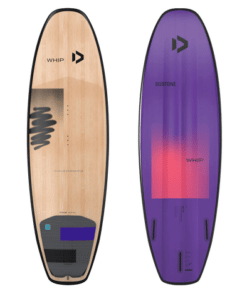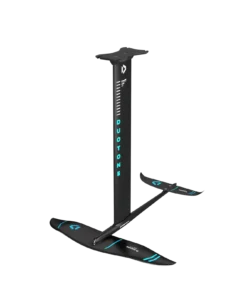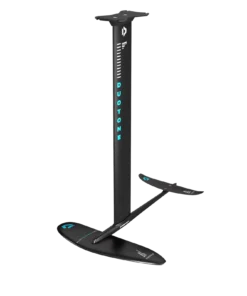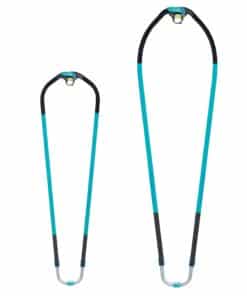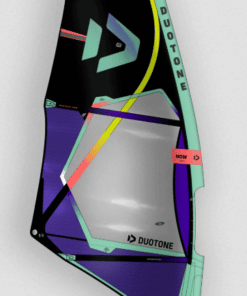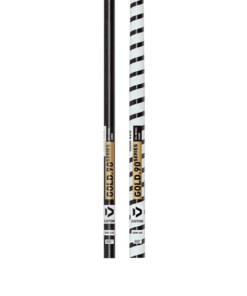*Pronta Consegna Boma Duotone Silver Mega Slim
409,00€ - 439,00€Fascia di prezzo: da 409,00€ a 439,00€
Vendita anche online accessori per windsurf:
Duotone Silver Mega Slim
Disponibile in pronta consegna nella misura 140-200
Spedizioni in tutta Italia.
Contattaci per disponibilità, sconti e preventivi.
Duotone Silver Mega Slim
YOU WANT IT ALL – GRIP COMFORT AND STIFFNESS OF A CARBON BOOM BUT AT AN AFFORDABLE PRICE! THE BRAND-NEW SILVER MEGA SLIM IS THE SKINNIEST ADULT ALLOY BOOM IN EXISTENCE.
With a tube diameter of 25.5mm (140 + 160 length) it’s just 0.5mm bigger than even the thinnest carbon booms out there (with the exception of our own PLATINUM booms 🙂
Best of all combining the stiffest 7075 alloy on earth with the unique OVAL TAIL SECTION and our secret PARTIAL SUBSEQUENT HEATING PROCESS the SILVER MEGA SLIM also becomes as stiff as most carbon booms out there.
And last but not least this all comes without any sacrifice in durability. That is why the SILVER MEGA SLIM is qualified for our unmatched 2 YEAR UNCONDITIONAL WARRANTY.
So it’s save to say the SILVER MEGA SLIM can’t be compared to any other alloy boom but is rather challenging high end carbon booms – especially if it comes to pricing.
The 140 and 160 lengths have received a completely new bend curve called NEW SCHOOL 2.0. For the first time it combines the advantages of a straight new school curve (no overstretching of the front hand) and a performance oriented curve (wider distance of the tubes in the center to avoid the sail profile from getting distorted).
In terms of unique features the SILVER MEGA SLIM is also in a league of it‘s own featuring the iFRONT 2.0 (lightest front-end on earth) and the VTS TAIL (visually indicating the correct outhaul tension).
Best for last all SILVER MEGA SLIM now feature an unmatched 60cm XL extension range covering an even broader range of sail sizes.
KEY FEATURES:
KNOWLEDGE BASE BOOMS
DUOTONE CARBON BOOM TECHNOLOGY – THINK DIFFERENT
We know that there are 2 challenges every windsurfing boom has to face:
- Fact #1: the longer the boom and the smaller the diameter the softer it becomes
- Fact #2: the smaller the diameter (in the grip area) the higher the grip comfort and the lower the fatigue (= longer sessions on the water and/or more power for the race)
Our aim was to achieve a long race boom, combining maximum grip comfort (through the thinnest possible grip diameter) with maximum stiffness – usually two things which can’t be combined as they work against each other.
Utilising the industry’s longest experience in engineering windsurfing booms after 3 years of relentless development we have come up with an innovative solution: SEGMENTED CROSS-SECTION TECHNOLOGY
Replacing the usual round cross section, the new PLATINUM SLS boom features 3 different cross sections each fulfilling individual tasks tailored to the specific section of the boom:
- FRONT-END SECTION
The front-end section, especially right next to the front-end, is responsible for approx. 30-40% of the total boom stiffness. The forces operate in multiple directions due to the lateral pull from your hands and the downward forces from your bodyweight. Therefore here the PLATINUM SLS features a massive square cross section which effectively increases the overall stiffness – in both directions, laterally and downward. - TAIL-END SECTION
The tail section has similar influence on the overall boom stiffness as the front section, although the influence increases the further you extend the boom length. Unlike the front section where the forces act in multiple directions, 90% of the forces on the tail section occur laterally as the main force comes from the sail pulling sideways. With the forces only operating in one direction, the most effective geometry here is an asymmetrical oval cross section that is horizontally orientated. - GRIP SECTION
By drastically increasing the stiffness in the front- and tail sections, we were able to reduce the outer diameter in the grip section by 1.5mm. Whilst this might not sound like much, in your hands the difference in grip comfort and fatigue is like day and night. To further increase grip comfort and reduce fatigue we have added a “bumper” to the inside.
The result? Our revolutionary SEGMENTED CROSS-SECTION TECHNOLOGY creates an unmatched racing boom setting a new benchmark for stiffness AND grip comfort.
Being even stiffer and lighter than the previous version with a reduced diameter in the grip area, as of today there is no other boom out there with a similar diameter-stiffness-weight ration than the new PLATINUM SLS!

Carbon offers the highest stiffness of all composite fiber. This ensures an unsurpassed stiffness-to-weight ratio.
Unfortunately though carbon has the lowest abrasion resistance of any composite fiber. Nowadays all front-ends are rotational which constantly “grind down” the carbon underneath. Over time, this initially increases the play between the front-end and the carbon body, eventually leading to potential breakage. The weak spot of any carbon boom is therefore the area below the front-end.
Our engineers have found a unique solution to avoid this by incorporating a very sophisticated bearing design. With our TRIANGLE BEARING CONSTRUCTION the carbon structure remains protected from abrasion even after years of use.

A boom with a rotational front-end needs side „bumpers“ to avoid the front-end from moving sideways. Usually these side „bumpers“ get moulded together with the rest of the boom body in „one shot“. This is how every carbon boom is produced. The problem with this process is that the carbon fibers get „folded“ in a 90° angle which causes a potential weak/breakage-spot. Our experience from the past showed that the majority of breakages occurred at exactly this spot.
Since 2019 all PLATINUM booms are made in our unique 2 PHASE BODY PRODUCTION. Means the side „bumpers“ get moulded onto the rest of the body in a 2nd process AFTER the body is finished. Since that time we don’t see any breakages in that area anymore.
The downside of this process is that the outside of the bumper area doesn’t look perfectly smooth. But rest assured this is purely aesthetic.
Drilled holes destroy the carbon structure and are therefore less durable – at least in theory. However, our experience on the water has shown that there is no difference compared to moulded recesses. To generate a moulded rcecess the carbon fibers must be „folded“ at a 90° angle which is just as bad for the structure as a drilled hole (see above under 2 PHASE BODY CONSTRUCTION).
On the other hand drilled holes are faster and cheaper in production. This allows us to spend the money where it really makes a difference to the durability (e.g. see above under TRIANGLE BEARING CONSTRUCTION).
BOOM BASICS
- NEW-SCHOOL/WAVE CURVE
On New School shaped booms the curve is concentrated in the first 25-30 cm while the rest of the boom is straight. This means that you don’t need to twist/bent your front hand even on smaller (wave) sails as it’s still positioned within the straight part. - CLASSIC/RACE CURVE
Classic shaped booms have a curve ranging further back to approx. 45cm. On smaller (wave) sails this means that the front hand is twisted/bent resulting in increased fatigue or even hand-wrist pain.
The larger the sail though the more the draft (and with it your hands) moves back so that the front hand isn’t twisted anymore.
Bigger sails also have a deeper profile. Classic shaped booms with their curve ranging further back make the boom become wider in the middle avoiding the sail touching the boom.
Therefore classic shaped booms are still the first choice for larger sized freeride/slalom sails (6.5 and up).

CARBON Vs ALUMINIUM
Carbon booms are 3 to 5 times more expensive than aluminium booms. The reasons for this drastic price difference are the massive difference in the raw material prices and the fact that a carbon boom is 100% custom/hand made.
Since carbon is a much stiffer raw material than aluminium carbon booms offer 4 essential advantages:
- When a gust hits your sail you need to pull hard to avoid loosing control. A softer boom bends more the harder you pull. This sideway bend results in the boom to become shorter. When the boom gets shorter the sail becomes fuller/baggy = loss of control.
The longer the boom (180 and up) the more obvious the difference in stiffness becomes. - Carbon booms can be made much lighter (up to 20%) while still offering at least 20% higher stiffness.
- With carbon you can go for thinner diameters (up to 4 mm) while still offering at least 20% higher stiffness. In general the thinner the tube diameter the more comfortable it becomes to hold on to. This becomes very obvious once you go back from a thin diameter to a thicker one.
- Carbon does not bend. Therefore a carbon boom usually lasts 3-4 times as long as an aluminium boom because any overload (crash, catapult, ..) will eventually result in a bent boom.
Also due to the fact that carbon doesn’t corrode a carbon boom requires much less care than an aluminium one. Check the condition of the ropes once in a while and worst case get the grip replaced and a carbon boom will last for years to come.
OUTSIDE Vs: INSIDE TAIL-END
Usually the longer and/or the more extended the boom the softer it gets. Problem is that the bigger the sail (= longer boom) gets the more crucial the boom stiffness becomes for the sail performance and wind range (see above CARBON VS. ALUMINIUM).
Since you pull with your back-hand when accelerating or pumping or when a gust hits your sail the tail-end section is the most crucial part for the overall stiffness of your boom. All booms nowadays either come with an inside- or outside tail-end.
OUTSIDE TAIL-END
Invented by the DUOTONE team back in 2007. Here the tail-end tubes slide OVER the boom body.
The larger tail diameter/cross-section increases the overall stiffness of your boom by minimum 30%. Plus in contrary to inside tail-ends the boom stiffness isn’t affected when you extend the boom length.
Nevertheless the outside tail-end has 2 limitations:
a. When changing the boom length you need to move the adjustment locking system alongside the tail-end tube. This makes it less comfortable and slower to operate.
b. With the usual 50 cm of adjustment range an outside tail-end requires a minimum boom length of 180 cm. Any shorter and your back-hand may end up being positioned on the (thick) tail-end tube.
INSIDE TAIL-END
This is the classic version to adjust your boom length since the beginning of booms becoming variable in length. Here the tail-end runs INside the boom body.
Advantages are:
> Works for any size/length of boom as the tail-end will never interfere with your back-hand.
> The adjustment locking system is fixed to the boom body. This way it’s easier, faster and more comfortable to adjust the boom length.
The only disadvantage is the reduced stiffness which gets worse the further you extend your boom. Usually the tail-end angle is parallel to the boom body angle (in the back). This way you have the least friction between the 2 parts making the tail-end slide very easily inside the boom body. This makes it very comfortable to adjust the length, sometimes up to a point that you can hear a certain “click-clack” when you’re heavily “wobbling” your boom.
The only way to increase the boom stiffness featuring an inside tail-end is to generate a certain “pre-tension” in the boom. To do so the angle of the tail-end gets increased so that it doesn’t match with the boom body anymore. With this pre-tension you increase the boom stiffness but at the same time remarkably reduce the comfort and ease of use when adjusting the length (therefore only used on PLATINUM 170).

Prodotti correlati
Tavole da Kitesurf: twintip freestyle e freeride, wave, surfino e strapless
Hydrofoil Kitesurf
Hydrofoil Kitesurf
Boma Windsurf
Boma Windsurf
Vele WindSurf
Accessori Kitesurf
*Pronta Consegna Barra Duotone Click Bar Quad Control 2026 ed Offerta anni precedenti
Accessori Windsurf
Alberi Windsurf
Accessori Kitesurf











